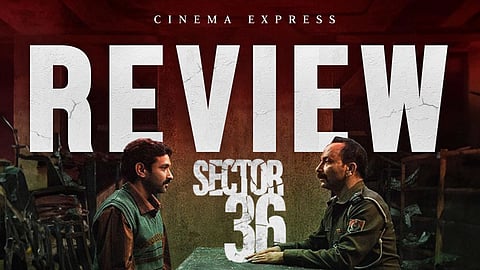Sector 36 Movie Review: Intriguing subject loses out to shock value
Sector 36(2.5 / 5)
If you were tired of watching Vikrant Massey playing the good guy all the time, you are in for a treat. But, maybe, nothing more. Sector 36, helmed by debutant director Aditya Nimbalkar, is another offering from the house of Netflix to satiate its subscribers of true crime. Nimbalkar has been the assistant director on all major projects of acclaimed filmmaker Vishal Bhardwaj and even served as co-writer for Talvar (2015), a film which deftly attempted to untangle the mess that was the Aarushi murder investigation. Sector 36 takes on the 2006 Nithari killings and presents it as a cat-and-mouse chase in the beginning and in noirish bleakness by the climax. Two different genres that hit independently but do not necessarily gel together.
Cast: Vikrant Massey, Deepak Dobriyal, Ipshita Chakraborty, Darshan Jariwala, Akash Khurana
Directed by: Aditya Nimbalkar
Streaming on: Netflix
The year is 2005. The setting is Delhi. Massey plays the presumptuous Prem, the caretaker of a posh kothi (bungalow) which is a pleasure pad for its owner Balbir Singh Bassi (Akash Khurana). As Bassi stays away most of the year, Prem saunters around in his boss’s velvet nightrobe and passes the time by watching a game show on TV (a copyright infringement-proof version of Kaun Banega Crorepati), cooing over the phone with his wife back in the village, and cutting up children at night. Parallelly runs the story of Ram Charan Pandey (a solid Deepak Dobriyal), a shuddh Hindi-speaking cop who considers a scientific law as philosophy. “Every action has an equal and opposite reaction,” he says in a voiceover. A portrait of Isaac Newton hangs next to his father’s and Lord Rama's. Merely an amusing touch which doesn’t develop into anything.
‘Missing’ posters bearing monochrome photos of kids from a nearby slum are crowding the pinboard at the police station, but Pandey is unconcerned until his own daughter narrowly escapes a kidnapping attempt. It’s an unimaginative way to give a personal motivation to the protagonist. And thus begins Pandey’s investigation into the rot of bureaucracy and power.
The characters sometimes show spark but often feel like stock. A bad uncle has a vicious gleam in his eye and a side grin or in order to depict evil, Massey’s Prem is shown wearing a demon mask with the Dussehra Raavan inflaming in the background. The visuals are sometimes innovative (the opening shot where Prem is lying on the sofa, half of his face reflecting in the glass table) other times dated (A man is jumped on in a hospital alley, the sign on the wall reads ‘Restricted Entry’). The film’s only way to create a gritty mood is the unabashed show of filth. We get a stream of blood flowing in a stained Indian toilet, a skeletal hand floating in the black muck of a nala and even a close-up of the bony remains of a Nalli-nihari. At times, I was impressed that the camera doesn’t shy away from showing the mess that is life, and death. But it soon started feeling a bit gratuitous. Like it was being done to sensationalise more than sensitise.
Sector 36 suffers from a derivative telling. The religious allegory has become passe since Paatal Lok and so have the insect metaphors (In a shot a shoe stomps over a cockroach, a similar scene was in the opening episode of the 2020 series). Vikrant’s performance, however, gives a boost to a predictable narrative. He approaches Prem with a loudness that felt initially overdone but then started growing on me. Case in point is an interrogation sequence close to the climax where Prem casually and quickly confesses to murdering and sexually assaulting “22 to 24” kids. Then he impatiently asks the cops to let him go, because he doesn’t want to miss his game show.
Inevitably, every Delhi noir tale ultimately becomes an exploration of class divide. But director Nimbalkar doesn’t venture into the deep end. Sector 36 only revels in the style. It lavishes in morbidity and takes creative liberty in simplifying a complicated and compromised investigation. Honest policemen get terminated, corrupt cops are pushed up the ladder, a predator is a predator because he was once groomed, the underprivileged wait for justice, violence and fate run in a circle and the system always prevails. What’s new?


